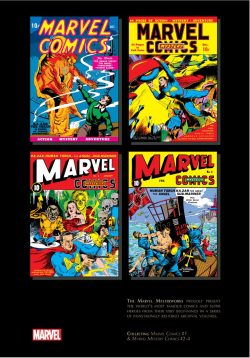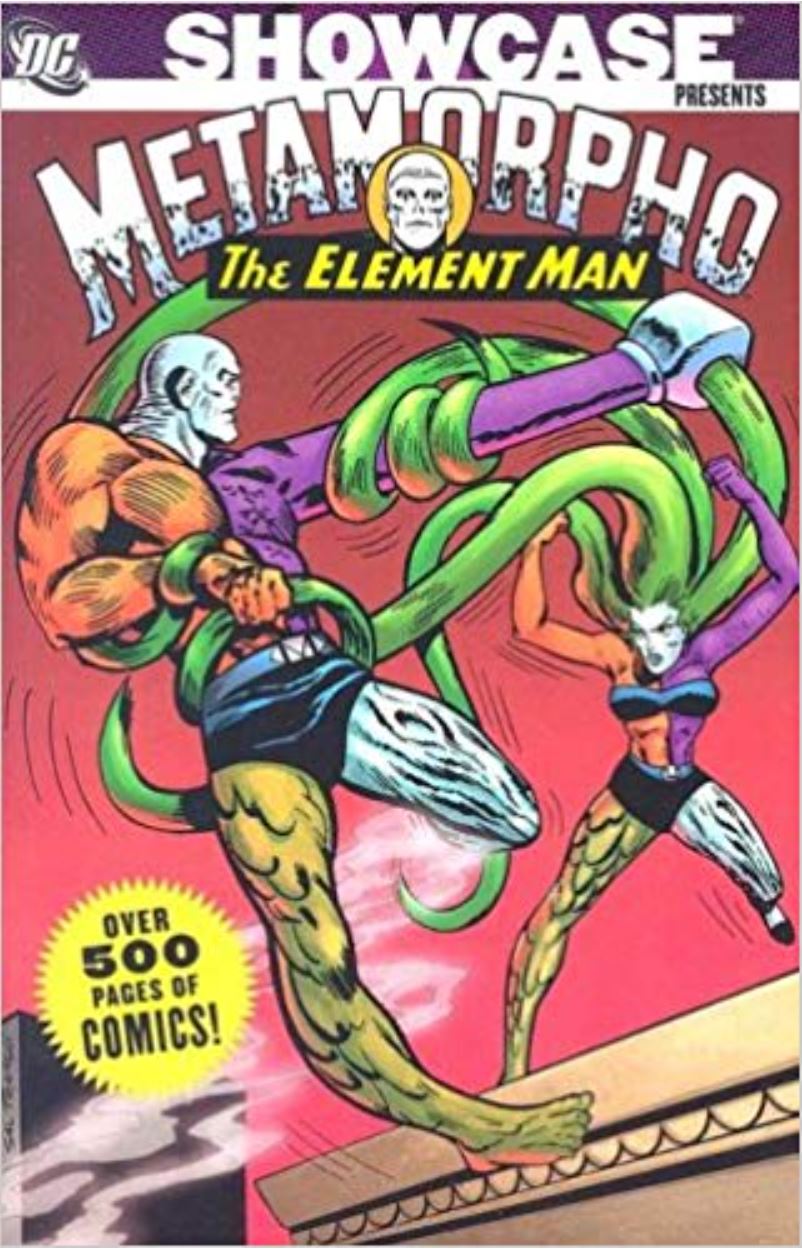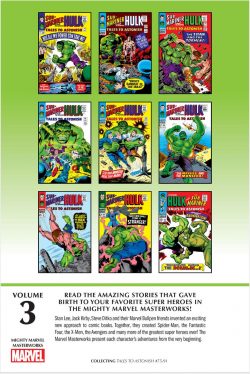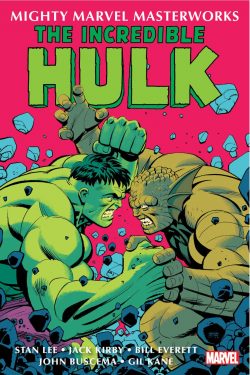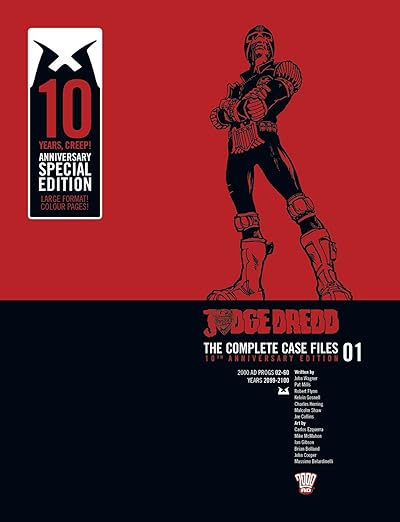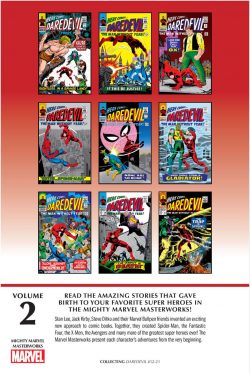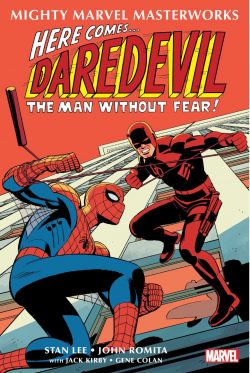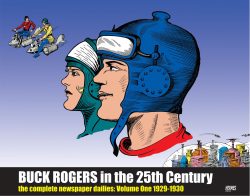
By Stan Lee & Jack Kirby, with Chic Stone, Vince Colletta, Frank Giacoia, Joe Sinnott, Tom Sutton & various (Marvel)
ISBN: 978-0-7851-8497-3 (TPB/Digital edition)
Officially debuting in 1965 and conceived as yet another incredible lost civilisation during Stan Lee & Jack Kirby’s most fertile and productive creative period, The Inhumans are a race of incredibly disparate (generally) humanoid beings genetically altered in Earth’s pre-history, and consequently evolving into a technologically-advanced civilisation far ahead of emergent Homo Sapiens.
They isolated themselves from the world and barbarous dawn-age humans, first on an island and latterly in a hidden valley in the Himalayas, residing in a fabulous city named Attilan. The mark of citizenship is immersion in mutative Terrigen Mists which further enhance and transform individuals into radically unique and generally super-powered beings. Inhumans are necessarily obsessed with genetic structure and heritage, worshipping the ruling Royal Family as the rationalist equivalent of mortal gods.
How the voluntary mutants joined the Marvel Universe can be traced in this compilation scrupulously gathering teasing early appearances in 1964 from Fantastic Four #36 and 38, the extended introductory saga from FF #41-47, 54 and 62-65, and a proper team-up tale from Fantastic Four Annual. Also included are pertinent extracts from FF #48, 50, 52 and 56-61, plus the entire Tales of the Uncanny Inhumans back-up series incongruously seen in Thor #146-153 and a moment of spoofish light-relief from Not Brand Echh #6, spanning cover-dates March 1965 (and on sale from December 10th 1964) to May 1968.
The first inkling of something epic in the wind came from Fantastic Four #36 (Lee, Kirby & Chic Stone) with the introduction of a ferocious female supervillain as part of the hero-team’s theoretical nemeses ‘The Frightful Four!’ A sinister squad – evil genius The Wizard, shapeshifting Sandman and gadget fiend The Trapster (he was in fact still Paste Pot-Pete here, but not for long) – were supplemented by enigmatic outsider Madame Medusa, whose origins were to have a huge impact on the MU in months to come.
FF# 38 saw a rematch with the heroes ‘Defeated by the Frightful Four!’ in a momentous tale with a startling cliff-hanger marking Stone’s departure in landmark manner. Vince Colletta assumed inking chores for a bombastic run which perfectly displays the indomitable power and inescapable tragedy of brutish Ben Grimm in a tense and traumatic trilogy in which the Frightful Four brainwash The Thing, turning him against his teammates. It starts in # 41 (August 1965) with ‘The Brutal Betrayal of Ben Grimm!’, continues in rip-roaring fashion with ‘To Save You, Why Must I Kill You?’ and concludes in bombastic glory with #43’s ‘Lo! There Shall be an Ending!’
The next issue was a landmark in many ways. Firstly, it saw the arrival of Joe Sinnott as regular inker: a skilled brush-man with a deft line and superb grasp of anatomy and facial expression, and moreover an artist prepared to match Kirby’s greatest efforts with his own.
Some inkers had problems with just how much detail The King would pencil in: Sinnott relished it and the effort showed. What had been merely wonderful became incomparable.
‘The Gentleman’s Name is Gorgon!’ premiered a mysterious powerhouse with metal hooves instead of feet: a hunter implacably stalking Madame Medusa.
His rampage through New York embroils the Human Torch – and subsequently the whole team – in Medusa’s frantic bid to escape, and that’s before monstrous android Dragon Man shows up to complicate matters. All this was merely a prelude: with the next episode readers were introduced to a hidden race of superbeings who had secretly shared Earth with humanity for millennia. ‘Among us Hide… the Inhumans’ revealed Medusa as part of the Royal Family of Attilan: rulers of a hidden race of paranormal beings. She had been on the run ever since a coup deposed the true king…
Black Bolt, Triton, Karnak and the rest would quickly become mainstays of the Marvel Universe, but their bewitching young cousin Crystal and giant teleporting dog Lockjaw were the real stars here. For young Johnny Storm, it was love at first sight, and Crystal’s eventual fate would greatly change his character, giving him a hint of angst-ridden tragedy that resonated greatly with the generation of young readers growing up with the comic…
‘Those Who Would Destroy Us!’ and ‘Beware the Hidden Land!’ (FF #46 and 47) saw the heroes unite with the Royals as Black Bolt battled to regain his throne from his brother Maximus the Mad, only to stumble into the usurper’s plan to wipe humanity from the Earth.
Ideas just seem to explode from Kirby at this time. Despite being halfway through one storyline, FF #48 trumpeted ‘The Coming of Galactus!’ with the first Inhumans saga swiftly wrapped up by page 7, and the entire subspecies sealed by Maximus behind an impenetrable dome called the Negative Zone (later retitled the Negative Barrier to avoid confusion with the gateway to sub-space Reed Richards had worked on for years). Those pages and further excerpts from #50 and 52 advance the “Inhumans-in-a-bottle” plot are included here, but you’ll need to seek elsewhere for the Galactus saga.
I suspect this experimental – and vaguely uncomfortable – approach to narrative mechanics was calculated and deliberate, mirroring the way TV soap operas increasingly delivered their interwoven storylines, and was here introduced as a means to keep readers glued to the series.
They needn’t have bothered. The stories and concepts were enough.
The next full story follows the Torch and college pal Wyatt Wingfoot as they seek a way to sunder the barrier and reunite Johnny with Crystal. This led to the unearthing of the lost tomb of Prester John in #54’s ‘Whosoever Finds the Evil Eye…!’ This became a running sub-plot with The Inhumans striving to break out whilst, on the other side of the Great Barrier, Johnny and Wyatt wandered the wilds also seeking a method of liberating the Hidden City.
The next major development occurs in snippets from FF #55-61 as Black Bolt at last liberates his imprisoned people, utilising the immeasurable power of his devastating voice: an uncontrollable sonic shockwave which can destroy everything – including the impenetrable energy barrier and the city trapped within it…
Free to follow her heart, Crystal finds Johnny just as Mr. Fantastic is lost in the antimatter hell of the Negative Zone’s sub-space corridor. ‘…And One Shall Save Him!’ (FF #62, May 1967) spotlights aquatic Inhuman Triton who steers the FF’s leader home to Earth after being lost, but the foray brings with them a terrifying brute who joins with earthly enemy Sandman. The battle against ‘Blastaar, the Living Bomb-Burst!’ is frantic and furious, mirroring the Royals’ explorations of the world beyond Attilan and subsequent explosive clash with agents of a totalitarian nation…
In ‘The Sentry Sinister’ – a frenetic romp pitting the FF against a super-robot buried for millennia by an ancient star-faring race – the first inkling of the Inhumans’ true origins can be found. This tropical treat expands the burgeoning interlocking landscape to an infinite degree by introducing the imperial Kree: also totalitarian and militaristic but on a cosmic scale and who would grow into a fundamental pillar supporting continuity in Marvel’s Universe.
Although regarded as long-dead, the Kree resurfaced in the very next issue when the team are attacked by an alien emissary ‘…From Beyond this Planet Earth!’ as formidable functionary Ronan the Accuser arrives to investigate what could possibly have destroyed a Kree Sentry. Simultaneously, as Johnny and Crystal’s romance grows more intense, her sister and cousins meet the Black Panther: sharing the stage with the Fantastic Four in that year’s Annual (#5, inked by Frank Giacoia), wherein sinister sub-microscopic invader Psycho-Man attempts to ‘Divide… and Conquer!’, pitting emotion-bending alien technology against both the King of the Wakandans and the Royal Family of Attilan until the Fab Four can pitch in…
The Annual also included the customary Kirby pin-ups: stunning shots of Inhumans Black Bolt, Gorgon, Medusa, Karnak, Triton, Crystal and Maximus plus a colossal group shot of Galactus, the Silver Surfer and others – all included here at no extra cost…
That same month the hidden race won their first solo feature: a series of complete, 5-page vignettes detailing some of the tantalising backstory so effectively hinted at in previous appearances. ‘The Origin of… the Incomparable Inhumans’ – by Lee, Kirby & Sinnott from Thor 146 (November 1967) – ranges back to the dawn of civilisation where cavemen flee in fear from technologically advanced humans who live on an island named Attilan. In that futuristic metropolis, wise King Randac finally makes a decision to test his people’s latest discovery: genetically mutative Terrigen rays…
The saga expanded a month later in ‘The Reason Why!’ as Earth’s Kree Sentry visits the island and reveals how in ages past its master experimented on an isolated tribe of primitive humanoids. After observing their progress, the menacing mechanoid learns the Kree lab rats have fully taken control of their genetic destiny and must now be considered Inhuman…
Skipping ahead 25,000 years, ‘…And Finally: Black Bolt!’ reveals how a newborn’s first cries wreck Attilan and reveal the infant prince to be an Inhuman unlike any other…
Raised in isolation, the prince’s 19th birthday marks his release into the city and full contact with the cousins he has only ever seen on video systems. Sadly, the occasion is co-opted by envious brother Maximus who tortures the royal heir to prove Bolt cannot be trusted to maintain ‘Silence or Death!’
Thor #150 (March 1968) saw the start of a continued tale as ‘Triton’ left the hidden city to explore the human world, only to be captured by a film crew making an underwater monster movie. Allowing himself to be taken back to America, the canny manphibian escapes when the ship docks and becomes an ‘Inhuman at Large!’ The story – and series – concluded with Triton on the run and acting as a fish out of water ‘While the City Shrieks!’, before returning to Attilan with a damning assessment of the human race…
Rounding off the thrills and chills is a silly snippet from Not Brand Echh #6 (the “Big, Batty Love and Hisses issue!” from February 1968) wherein ‘The Human Scorch Has to… Meet the Family!’: a snappy satire on romantic liaisons from Lee, Kirby & Tom Sutton, appended with creator biographies and House Ads for the Inhumans’ debut.
These are the stories that introduced another strand of outsiders to the maverick Marvel universe and cemented Kirby’s reputation as an innovator beyond compare. They also helped the company to overtake all its competitors and are still some of the best stories ever produced: as exciting and captivating now as they ever were. This is a must-have book for all fans of graphic narrative or potential fans of Marvel’s next cinematic star vehicle.
© 1965, 1966, 1967, 1968, 2017 Marvel Characters, Inc. All rights reserved.

